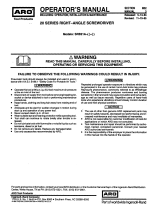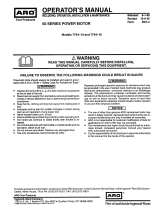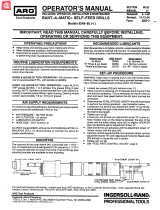Page is loading ...

OPERATOR’S MANUAL
Tool Products
INCLUDING: OPERATION, INSTALLATION & MAINTENANCE
“2200” SERIES DRILL
Released: 6-30-95
Revised:
Model 7696
325 R.P.M.
WARNING
READ THIS MANUAL CAREFULLY BEFORE INSTALLING,
OPERATING OR SERVICING THIS EQUIPMENT.
FAILURE TO OBSERVE THE FOLLOWING WARNINGS COULD RESULT IN INJURY.
Pneumatic tools should always be installed and used in accor-
dance with A.N.S.I. 6166.1 “Safety Code For Portable Air Tools.”
l
l
0
a
l
l
l
l
0
l
Operate this tool at 90 p.s.i.g. (6.2 bar) maximum air pressure
at the air inlet of the tool.
Disconnect air supply from tool before removing/installing bit,
socket or device attached to tool or performing maintenance
procedures.
Keep hands, clothing and long hair away from rotating end of
tool.
Anticipate and be alert for&Mien changes in motion during
start up and operation of any power tool.
Never exceed rated r.p.m. of tool.
Wear suitable eye and hearing protection while operating tool.
Tool shaft can continue to rotate briefly after throttle is re-
leased.
Do not lubricate tools with flammable or volatile liquids such as
kerosene, diesel or jet fuel.
Do not remove any labels. Replace any damaged label.
Use only accessories recommended by ARO.
Repeated prolonged operator exposure to vibrations which may
be generated in the use of certain hand-held tools may produce
Raynaud’s phenomenon, commonly referred to as Whitefinger
disease. The phenomenon produces numbness and burning
sensations in the hand and may cause circulation and nerve dam-
age as well as tissue necrosis. Repetitive users of hand-held
tools who experience vibrations should closely monitor duration
of use and their physical condition.
l
The use of other than genuine ARO replacement parts may
result in safety hazards, decreased tool performance and in-
creased maintenance and may invalidate all warranties.
l
ARO is not responsible for customer modification of tools for
applications on which ARO was not consulted.
• Tool maintenance and repair should be performed by autho-
rized, trained, competent personnel. Consult your nearest
ARO authorized servicenter.
l
It is the responsibility of the employer to place the information
in this manual into the hands of the operator.
For parts and service information, contact your local ARO distributor, or the Customer Service Dept. of the Ingersoll-Rand Distribution
Center, White House, TN at PH: (615) 672-0321, FAX: (615) 672-0801.
ARO Tool Products
Ingersoll-Rand Company
1725 U.S. No. 1 North
l
P.O. Box 8000
l
Southern Pines, NC 28388-8000
©1995 THE ARO Corporation PRlNTED IN USA
Part of worldwide Ingersoll-Rand

FAILURE TO OBSERVE THE FOLLOWING WARNINGS COULD RESULT IN INJURY.
WARNING
Wear eye protection when
operating or performing
maintenance on this tool.
I
WARNING
I
Wear hearing protection when
operating this tool.
WARNING
I
WARNING
Turn off air supply and disconnect
air supply hose before installing,
removing or adjusting any
accessory on this tool, or before
performing any maintenance on
this tool.
I
WARNING
I
Do not carry the tool by the hose.
WARNING
Do not overreach when operating
this tool. Keep body stance
balanced and firm.
NOTICE
This label must appear on
the tool at all times. If it is
PN 48176-1 LABEL
placement label is avail-
able at no cost.
Air powered tools can vibrate in
use. Vibration, repetitive motions
or uncomfortable positions may
be harmful to your hands and
arms. Stop using any tool if
discomfort, tingling feeling or
pain occurs. Seek medical advice
before resuming use.
WARNING
Do not use damaged, frayed or
deteriorated air hoses and
fittings.
WARNING
Operate at 90 p.s.i.g.
(6.2 bar/620 kPa)
maximum air pressure.
WARNING = Hazards or unsafe practices which could result in severe personal injury, death or substantial
property damage.
CAUTION = Hazards or unsafe practices which could result in minor personal injury or product or property
damage.
NOTICE = Important Installation, operation or maintenance information.
2

ROUTINE LUBRICATION REQUIREMENTS
Lack of or an excessive amount of lubrication will affect the perfor-
mance and life of this tool. Use only recommended lubricants at
below time intervals:
EVERY 8 HOURS OF TOOL OPERATION - Fill lubricator reser-
voir of recommended F.R.L. with spindle oil (29665). If an in line or
air line lubricator is not used, apply several drops of spindle oil
(29665) in air inlet.
EVERY 46 HOURS OF TOOL OPERATION - Flush tool with a
solution of three (3) parts cleaning solvent to one (1) part spindle
oil. After flushing, apply a small amount of spindle oil in air inlet and
run tool for one minute to insure proper lubrication. Built-in oiler
reservoir should be filled with spindle oil (29665).
EVERY 160 HOURS OF TOOL OPERATION - Lubricate gear-
ing. Pack bearings, coat shafts and lubricate gears with NLGI #1
“EP” grease (33153). Gearing should contain approximately 1/4
oz. (7 g) of grease per reduction.
AIR SUPPLY REQUIREMENTS
For maximum operating efficiency, the following air supply specifi-
cations should be maintained to this air tool:
l
AIR PRESSURE - 90 p.s.i.g. (6.2 bar)
l
AIR FILTRATION - 50 micron
. LUBRICATED AIR SUPPLY
l
HOSE SIZE - 5/16” (8 mm) I.D.
An ARO® model C28231-810 air line FILTER/REGULATOR/LU-
BRICATOR (F.R.L.) is recommended to maintain the above air
supply specifications.
RECOMMENDED LUBRICANTS
After disassembly is complete, all parts, except sealed or shielded
bearings, should be washed with solvent. To relubricate parts, or
for routine lubrication, use the following recommended lubricants:
Air Motor
“0” Rings & Lip Seals
1 qt Spindle Oil
36466
Gears and Bearings
4 oz. Stringy Lubricant
33153
5
lb. “EP” - NLGI #1 Grease
INSPECTION, MAINTENANCE AND INSTALLATION
Disconnect air supply from the tool or shut off air supply and ex-
haust (drain) line of compressed air before performing mainte-
nance or service to the tool.
It is important that the tools be serviced and inspected at regular
intervals for maintaining safe, trouble-free operation of the tool.
Be sure the tool is receiving adequate lubrication, as failure to lu-
bricate can create hazardous operating conditions resulting from
excessive wear.
Be sure that the air supply lines and connectors are of proper size
to provide a sufficient quantity of air to the tool.
Tool maintenance and repair shall be performed by authorized,
trained, competent personnel. Tools, hose and fittings shall be re-
placed if unsuitable for safe operation and responsibility should
be assigned to be sure that all tools requiring guards or other safe-
ty devices shall be kept in legible condition. Maintenance and re-
pair records should be maintained on all tools. Frequency of
repair and the nature of the repairs can reveal unsafe application.
Scheduled maintenance by competent authorized personnel
should detect any mistreatment or abuse of the tool and worn
parts. Corrective action should be taken before returning the tool
for use.
Disassembly should be done on a clean work bench with a clean
cloth spread to prevent the loss of small parts. After disassembly
is completed, all parts should be thoroughly washed in a clean sol-
vent, blown dry with air and inspected for wear levels, abuse and
contamination. Double sealed or shielded bearings should never
be placed in solvent unless a good method of m-lubricating the
bearing is available. Open bearings may be washed but should
not be allowed to spin while being blown dry.
Upon reassembling, lubricate parts where required. Use 33153
grease, or equivalent, in bearings. Use 36460 lubricant for “0
ring assembly. When assembling “0” rings or parts adjacent “0
rings, care must be exercised to prevent damage to the rubber
sealing surfaces. A small amount of grease will usually hold steel
balls and other small parts in place while assembling.
When replacement parts are necessary, consult drawing contain-
ing the part for identification.
Always use clean, dry air. Dust, corrosive fumes and/or excessive
moisture can damage the motor of an air tooL An air line filter can
greatly increase the life of an air tool. The filter removes rust,
scale, moisture and other debris from the air lines. Low air pres-
sure (less than 90 p.s.i.g.) reduces the speed of the air tool. High
air pressure (more than 90 p.s.i.g.) raises performance beyond
the rated capacity of the tool and could cause injury. Shown below
is a typical piping arrangement.
SYSTEM
TO
AIR
TOOL
LUBRICATOR
REGU
MAIN LINES 3 TIMES
AIR TOOL INLET SIZE
BRANCH LINE 2 TIMES
AIR TOOL INLET SIZE
COMPRESSOR
DRAIN REGULARLY
3

34
I
36 36
33
32
0 TORQUE TO 9 - 12 FT LBS.
0 TORQUE TO 28 IN. LBS.
$ FLUSH FACE TYPE BEARING -ASSEMBLE
WITH FLUSH FACE TOWARDS END PLATE.

18 17 16
15 14
4
6
8
9
10
11
12
13
15
16
1
6
NOT SHOWN
37665 DEAD HANDLE
37167 WRENCH
48176-1 WARNING LABEL
23
25
22:
28
29
3a
:;
33
ii
36
37
ii
40
41
4:
z
:
47
48
49
50
2
53
54
55
56
57
ii
E
z
z
,
I
/
I
I
,
I
i
I
i
,
Regulator Body
......................
Air Regulator Assembly (includes items 1
thru 4) .............................
Muffler Assembly
....................
Screen .............................
Inlet Adapter
........................
“0” Ring
............................
“0” Ring
............................
Insert ..............................
Insert Assembly (includes items 9 and 10)
Spring ..............................
“O” Ring
............................
Valve Stem .........................
Oil Screw
...........................
Washer
.............................
Housing (includes item 17)
............
Grease Fitting
.......................
Oilite Casting
........................
Screw ..............................
Guide Pin
...........................
Spring
..............................
Trigger
.............................
Pistol Grip Housing Assembly (includes
items 6 thru 22)
.....................
Nut ................................
Sems Fastener ......................
Bearing .............................
Rear End Plate
......................
Spacer .............................
Rotor ...............................
Blade (5 req’d)
......................
Roll Pin (2 req’d)
.....................
Cylinder (includes item 30)
............
Front End Plate
......................
Bearing .............................
Motor Assembly
.....................
Spacer .............................
Spacer .............................
Lock Nut
............................
Bearing .............................
Shaft (2 req’d)
.......................
Needle Bearing (4 req’d)
..............
Gear (2 req’d) 18 teeth
...............
Spindle
.............................
Snap Ring
..........................
Bearing
.............................
Retaining Ring
......................
Ring Gear (includes item 47)
..........
Grease Fitting
.......................
Auxiliary Gearing Assembly (7.43:1)
....
Bearing .............................
Shaft (2 req’d)
.......................
Needle Bearing (4 req’d)
..............
Gear (2 req’d) 18 teeth
...............
Spindle
.............................
Snap Ring ..........................
Bearing .............................
Wave Washer
.......................
Washer
.............................
Ring Gear
..........................
Seal ...............................
Nose Housing (includes item 61)
.......
Grease Fitting
.......................
Spacer
.............................
Drive Gearing Assembly (7.43:l)
.......
Adapter Body (1/2” square drive) .......
Locking Pin .........................
Rubber Insert
.......................
Adapter Assembly (1/2” square drive)
...
I
I
I
!
I
I
1
PART NUMBER FOR ORDERING
Snap Ring (2 req’d)
..................
“0” Ring (2 req’d)
....................
Regulator Valve
.....................
t
Y111-3
Y325-8
36975
37527
37526
40192
33911
37073
Y325-13
Y325-112
37070
37981
Y325-7
39288
30747
31389
37064
35667
33190-1
39769
39769
32858
39764
40177
33664
33700
33709
33710
33701
41521
41520
Y 178-20
35679
33712
33705
41522
33699
33711
35831
33704
40841
42271
46416
40840
40843
33704
33706
35270
35323
40626
33704
40841
42271
46416
40636
40843
33706
47589
47590
37774
38379
36967
33597
41770
40767
31386

DISASSEMBLY/ASSEMBLY INSTRUCTIONS
Never apply excessive pressure by a holding device which
may cause distortion of a part.
Apply pressure evenly to parts which have a press fit.
Apply even pressure to the bearing race that will be press
fitted to the mating part.
Use correct tools and fixtures when servicing this tool.
Don’t damage “0” rings when servicing this tool.
Use only genuine ARO replacement parts for this tool. When
ordering, specify part number, description, tool model number
and serial number.
DRIVE GEARING DISASSEMBLY
Clamp tool in a smooth face vise, clamping on housing (16).
Place a wrench on adapter body (64) and strike wrench a
sharp blow to loosen adapter body.
Remove adapter body (64) and spacer (62).
Using wrenches on flats of nose housing (60) and ring gear
(46) unthread and remove drive gearing.
Remove nose housing (60) and seal (59) from ring gear.
Grasp ring gear (58) in one hand and tap threaded end of
spindle (53) with a soft face hammer; spindle and components
will loosen from ring gear.
Do not disassemble further unless damage is evident, as Brin-
elling of the bearing races may occur, making replacement
necessary.
To disassemble, remove bearing (55).
Turn snap ring (54) so the open portion allows removal of shaft
(50).
Remove shaft (50) releasing gear (52).
Repeat for removal of opposite shaft and gear.
Place shafts (50) into spindle and alternately tap ends to re-
move bearing (49).
DRIVE GEARING ASSEMBLY
Assemble snap ring (54) to groove in spindle, aligning open
portion of snap ring with hole for shaft.
Lubricate needle bearings (51) with ARO 33153 grease and
assemble to gears (52).
Lubricate gears (52) liberally with ARO 33153 grease and as-
semble one gear to spindle, securing with shaft (56).
Repeat for opposite shaft and gear.
After assembly of gears and shafts, turn snap ring so open
portion is approximately 90° from either shaft.
Assemble bearing (55) to spindle, pressing on inner race of
bearing.
Pack bearing (49) with ARO 33153 grease and assemble to
spindle, pressing on inner race of bearing.
Assemble washer (57) wave washer (56) and spindle and
components into ring gear (58).
Assemble seal (59) and nose housing (60) to ring gear (56).
Assemble drive gearing to tool and tighten, using wrenches
on flats of nose housing (68) and ring gear (46).
Assemble spacer (62) and adapter body (64) to spindle.
Assemble locking pin (65) to adapter body (64) securing with
rubber insert (66).
AUXILIARY GEARING DISASSEMBLY
Remove drive gearing from tool.
Using a wrench on flats of lock nut (37) loosen lock nut and
remove auxiliary gearing from tool.
Grasp ring gear in one hand and tap drive end of spindle with a
soft face hammer; spindle and components will loosen from
ring gear.
Do not disassemble further unless damage is evident, as Brin-
elling of the bearing races may occur, making replacement
necessary.
To disassemble, remove bearing (44).
Turn snap ring (43) so the open portion allows the removal of
shaft (39).
Remove shaft (39). releasing gear (41).
Repeat for removal of opposite shaft and gear.
Place shafts (39) into spindle and alternately tap ends to re-
move bearing (38).
AUXILIARY GEARING ASSEMBLY
Assemble snap ring (43) to groove in spindle, aligning open
portion of snap ring with hole for shaft,
Lubricate needle bearings (40) with ARO 33153 grease and
assemble to gears (41).
Lubricate gears liberally with ARO 33153 grease and as-
semble one gear to spindle, securing with shaft (39).
Repeat for opposite shaft and gear.
After assembly of gears and shafts, turn snap ring so open
portion is approximately 90° from either shaft.
Pack bearings (44 and 38) with ARO 33153 grease and as-
semble to spindle, pressing on inner race of bearings.
Assemble spindle and components into ring gear.
Thread lock nut (37) all the way onto ring gear.
Assemble auxiliary gearing to tool and tighten, using a wrench
on flats of ring gear.
Tighten lock nut (37) against housing (16) securing auxiliary
gearing.
Assemble drive gearing to tool.
MOTOR DISASSEMBLY
Remove gearing from tool.
Remove spacers (36 and 35) and motor assembly from hous-
ing (16).
Using a spanner type wrench, remove nut (23) from end plate
(26).
Grasp cylinder in one hand and tap splined end with a soft face
hammer; motor will come apart,
Remove sems fastener (24) releasing bearing (25) and end
plate (26).
MOTOR ASSEMBLY
Pack bearings with ARO 33153 grease.
Assemble bearing (25) to end plate (26) pressing on outer
race of bearing. NOTE: Assemble bearing to end plate with
the identification markings facing out.
Assemble spacer (27) and end plate (26) to rotor, pressing on
inner race of bearing.
Assemble sems fastener (24) to rotor, securing bearing and
end plate. Torque fastener to 28 in. Ibs.
Coat five rotor blades (29) with ARO 29665 spindle oil and as-
semble to rotor slots - straight side out.
Coat i.d. of cylinder (31) with ARO 29685 spindle oil and as-
semble over rotor, aligning roll pin (30) with hole in end plate.
Assemble bearing (33) to end plate (32) pressing on outer
race of bearing.
Assemble end plate (32) to cylinder, pressing on inner race of
beating.
Assemble nut (23) to end plate (26) and tighten, using a span-
ner type wrench. Torque to 9 - 12 ft Ibs.
Be sure rotor does not bind.
Assemble motor assembly and spacers (35 and 36) to hous-
ing (16).
Assemble gearing assemblies to tool.
HOUSING DISASSEMBLY
Remove snap ring (1). releasing regulator valve (3) and “0”
rings (2).
Remove regulator body (4), screen (6), inlet adapter (7), “0”
ring (8) insert (10) and spring (11).

DISASSEMBLY/ASSEMBLY INSTRUCTIONS
Depress trigger (22) to release valve stem (13) and “0” ring
(12).
Grease “0” ring (9) and assemble to groove in insert (10).
Assemble spring (11) and insert (10) into housing.
Grease “0” ring (8) and assemble “0” ring and
(7) to housing, securing valve components.
inlet adapter
Clean and replace screen (6) in inlet adapter.
Grease “0” rings (2) and assemble to grooves in regulator
valve (3).
Remove screw (19) and guide pin (20). releasing trigger (22)
and spring (21).
To remove oilite casting (18), unscrew from “motor” end of
housing.
HOUSING ASSEMBLY
Assemble spring (21) and trigger (22) into housing, securing
with guide pin (20) and screw (19).
Grease “0” ring (12) and assemble to groove in valve stem
(13).
Lubricate valve stem (13) with ARO 29665 spindle oil and as-
semble into housing.
Assemble regulator valve (3) to regulator body (4) securing
with snap rings (1).
Assemble regulator body (4) to inlet adapter (7).
Assemble oilite casting (18) into housing.
Fill cavity in housing (16) with ARO 29665 spindle oil and seal
with washer (15) and oil screw (14).
7

/








